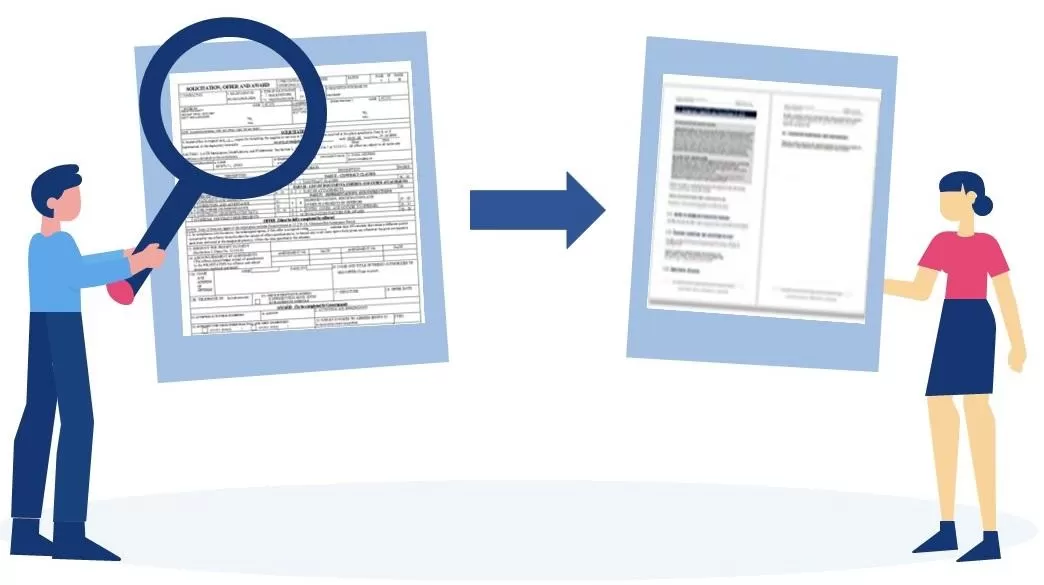Ambiguity in the language of the RFP can make it difficult to determine what the customer’s expectations are and how you should structure your proposal to fulfill them.
Often an RFP will describe in a narrative what they want you to address in your proposal. To prepare your proposal you have to create an outline based on what they have described. You have to decide what topics should get headings and what topics should be addressed under the headings you identify. Doing this will involve making judgment calls. To help you decide, consider the following:
- What will their evaluation forms look like? When they score your proposal, it should be based on the structure they tell you to use. So if you were writing the RFP and preparing forms for someone else to use to perform the evaluation, what fields would you have on the forms? Some of the words in the RFP will be headings on the form and some will be clarifications. You want them to be able to easily complete their forms, so you should have the same headings you envision them having.
- Look for words that indicate requirements. RFPs often use words like “shall, must, will, have, include, required, etc.” to indicate specific requirements. Often a paragraph can be broken down into several line items marked by these words.
- Be careful with lists in the RFP. Whether a list of requirements gets separate headings or one heading for the whole list depends on whether you think the customer is looking for a single collective response or whether they want to see compliance with each one individually.
- How can you make your compliance with the RFP more visible? You want them to see, ideally from the Table of Contents without even reading anything, that your proposal addresses everything in the RFP. Put as many keywords from the RFP in your headings as you can.
- Too many headings are better than too few. Documents with lots of headings are generally easier to read than documents with few headings. This is especially true for proposals, which aren’t read like a book, but rather scored by someone who probably doesn’t want to read it at all.
- How do you handle redundancy and overlap? Often the RFP will describe things in more than one way, with a series of words, or with layers of clarification. You will need to decide which words will go into the headings and which words should go into the narrative. If the RFP requires it, you may have to address the same subject matter in more than one place. If possible, make the context different (for example, addressing “risk mitigation” should be different in the management plan than it is in the technical approach) so that the actual redundancy is minimized.
- Use section cross-references. Unless the RFP says not to, then you should use something like “please see section X for more detail about…” wherever you need to. This helps eliminate redundancy.
- How do you handle things that are missing? Sometimes responding fully will require addressing something that they didn’t mention in the RFP, or to substantiate, clarify, justify, preserve a sequence, etc. You may need to add a heading, or try to address it under one of the existing headings in order to accommodate the topic.
- How many levels deep should your headings go? While you want to avoid five, six, or more levels of headings, if the RFP drives you to it then it’s acceptable. But do try to avoid going more than a level or two deeper than the RFP itself.
- Use unnumbered headings. If you want to give something visibility, but don’t care if it shows in the Table of Content, you can use unnumbered subheadings.
- How to cope with contradictions and conflicts. Sometimes an RFP will contradict itself. Some conflicts are more subtle. If you can’t resolve these by asking questions, then you’ll have to deal with them in writing. Try to avoid contradictions in the headings by moving them to the text where you can explain things in more detail. In the text you can make assumptions, offer options, promise both sides of the contradiction, or simply say that you’ll seek the client’s guidance after award.
- Don’t forget the unwritten requirements. If you have followed the Readiness Review methodology, then you will probably have information about the customer and the opportunity that goes beyond what is in the RFP. This information needs to figure prominently in your proposal, even though it is not mentioned in the RFP. Depending on the nature of the information, you may decide to incorporate it in the narrative response under an existing heading, or you may wish to create a heading to focus attention on it even though the heading is not mandated by the RFP.



Let's discuss it!
You can post now and register later. If you have an account, sign in now to post with your account.
Note: Your post will require moderator approval before it will be visible.